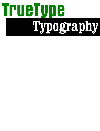
N.B. An asterisk before a word means it has its own entry in the glossary.
- AAT
-
Apple Advanced Typography, the new name for all the things you used to call *GX Typography, plus some new things. AAT includes native Type 1 support (no ATM needed), can use Windows TrueType fonts (TTF files), and normal fonts do not need to be *GXified. This is all in OS 8.5. When OS/X comes along, *OpenType will also be supported.
- advance width
-
The measurement from a *glyph's horizontal origin to the intended default origin for the next character.
The advance width and *LSB, together constituting the metrics for each glyph, are stored in TrueType's *'hmtx' table. These metrics can be adjusted during *hinting to control character spacing at low resolution (see *phantom points). Without this feature (using Type 1 fonts with ATM, for instance) adjacent characters may collide at low *ppem values.
TrueType provides the *'hdmx' table for precomputed (i.e. scaled and instructed) LSB and advance width values. - aliasing
-
A set of problematic effects resulting from the usual method of displaying *scalable images on low-resolution screens.
When converting these images to *bitmaps for display, samples are taken from the theoretical mathematical image, usually at the pixel centres. The influence of what is happening at these more or less arbitrary points is thereby greatly exaggerated, causing jagged edges, "pimples" and other undesirable effects. (We should really be considering what is happening over the complete area covered by each pixel.)
The approach to the problem that takes the generic term, *anti-aliasing, normally denotes careful shading of border pixels. Another approach (distinct but complementary) is *hinting, a set of techniques that can in principle regularize features of any graphic, but in practice is confined to font technology. - anti-aliasing
-
One solution to the *aliasing problem. The pixels of the graphic being displayed are shaded by analysing them as areas (not dimensionless points) on a theoretical infinite *resolution output surface. In practice it's adequate to resample on a grid 2 to 16 times as fine as the original device grid - meaning 5 to 257 grey levels respectively. See the TrueType Anti-Aliasing page.
- ATM
-
Adobe Type Manager, the Adobe *rasterizer for displaying Type 1 fonts on screen (rather than on the printer, where Type 1 rasterizing is part of PostScript). ATM is included with any font from Adobe and the free Acrobat reader.
ATM has been released for many computer platforms, including Mac and Windows. It will soon not be necessary to install ATM at all: a Type 1 rasterizer is to be part of Mac OS 8.6, and Windows 2000 will also rasterize Type 1 fonts natively.
ATM Deluxe is a rather good utility for managing Type 1 and TrueType fonts, but you have to pay for it. - auto-hinting
-
A facility within a font tool to add *hints to a font automatically. Most font tools, including *Fontographer and *FontLab, have such functionality. A few tools, e.g. *StingRay, are dedicated to auto-hinting.
The algorithms used are generally not known to the user, so best results are achieved via trial and error. Algorithms typically analyse the features of *glyphs, and attempt to hint similar features the same way. While it is unfeasible that a computer should make the same hinting decisions as a trained typographer, auto-hinting on simple text fonts nearly always improves the font from an unhinted version. However with complex fonts, or with logos, there may well be no overall improvement. An expert typographic engineer can always substantially improve on an auto-hinted font. - axis
-
See *design axis.
TYPE*chimérique | TrueType Typography | TYPE*links